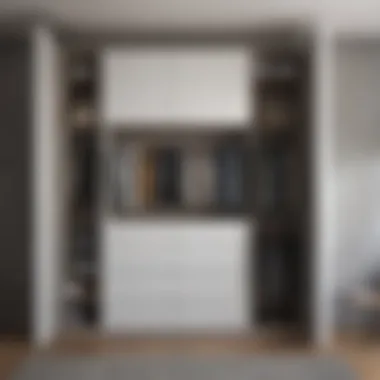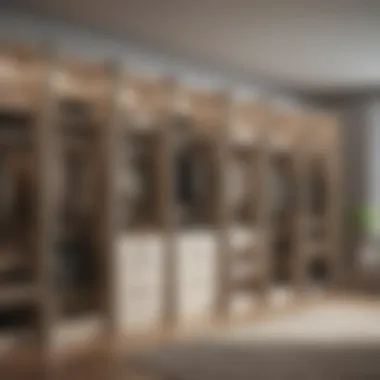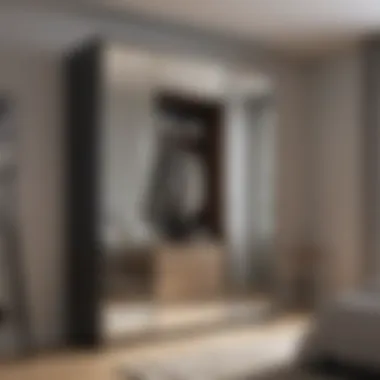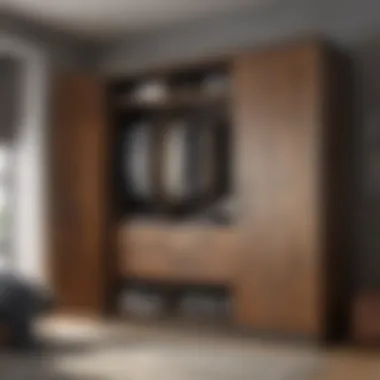Innovative Bedroom Wardrobe Closet Designs


Intro
Creating a well-organized bedroom is essential for a peaceful environment. The closet plays a key role in maintaining order. Innovative wardrobe closet designs not only improve functionality but also add to the aesthetic appeal of the space. This article presents a thorough exploration of contemporary wardrobe designs, focusing on how different styles and materials can optimize space and enhance the overall bedroom atmosphere.
Current Trends
As bedrooms evolve, so do the wardrobes within them. Several trends currently drive the design of bedroom closets.
Color Palettes
Neutral colors are prevalent for wardrobe designs. Shades like white, beige, and soft gray are popular as they offer a timeless appeal. Darker colors like navy blue or charcoal can provide a striking contrast and add sophistication. Mixing these color palettes strategically can create a balanced yet modern look.
Popular Styles
Minimalist wardrobes are in high demand. Scaled-down designs promote simplicity and decluttering. Sliding doors are a feature of modern wardrobes and save space. Additionally, open shelving designs allow for easy access to items while also showcasing decor. Other homeowners prefer vintage styles, incorporating ornate details and wooden finishes.
Visual Ideas
Visual inspiration can significantly help in selecting wardrobe designs that fit individual needs.
Gallery of Styled Bedrooms
A well-curated gallery can showcase how various wardrobe designs can enhance bedroom aesthetics. Whether it’s a sleek, built-in wardrobe or a standalone wooden unit, the style should complement the overall decor of the room. Pictures can illustrate effective use of space that fits particular themes.
Before-and-After Transformations
Before-and-after images can show the impact of a redesigned wardrobe. These examples reveal how updated styles not only improve functionality but also provide greater visual appeal to the bedroom. Small changes, such as replacing doors or reorganizing shelves, can dramatically alter the atmosphere.
"The right wardrobe design can change the entire dynamics of the bedroom, offering both practicality and style."
The End
Prologue to Bedroom Wardrobe Closet Designs
In today’s homes, where space can be limited, effective wardrobe designs become even more crucial. They maximize every square foot, offering space-saving options that reduce clutter and promote a serene environment. Optimal design can also lead to a more personalized touch in the bedroom, creating a cohesive look that reflects the homeowner’s taste.
Understanding the different elements of innovative wardrobe designs helps in making informed decisions. By focusing on functionality and aesthetics, individuals can choose wardrobes that serve their unique needs while elevating their living spaces. This introduction sets the stage for exploring the various designs available, their key components, and the importance of thoughtful planning for successful wardrobe integration.
Understanding the Role of Wardrobes in Bedroom
Wardrobes play a fundamental role in the bedroom. They are essential for storing clothing, accessories, and personal items, making them critical to maintaining an organized space. In a busy household, where efficiency is key, a well-planned wardrobe system can streamline daily routines.
Furthermore, wardrobes contribute to the overall aesthetics of a bedroom. A thoughtfully designed wardrobe can become a focal point or blend seamlessly into the room’s design. Bespoke wardrobes can complement existing furniture, while store-bought options might provide the right style and form without the need for extensive customization.
In addition to function and visual appeal, wardrobes must also consider personal lifestyle. For example, someone with extensive formal wear may benefit from a wardrobe designed with ample hanging space. In contrast, a casual dresser may prefer more shelving and drawers for rolled-up clothes and accessories. This versatility showcases the role of wardrobes not just as furniture but as essential tools in optimizing bedroom functionality.
Why Design Matters
Design is an integral part of how users experience their spaces. In bedroom wardrobe closet designs, the importance of design cannot be overstated. An effective design offers not just visual satisfaction but functionality that aligns with the homeowner’s needs.
Good design should take into account the flow of the room. For instance, a wardrobe's positioning can affect how one navigates the space. Therefore, considering layout and access points ensures that the wardrobe complements the bedroom rather than obstructing it.
Moreover, design choices also impact durability and maintenance. Quality materials can enhance the longevity of a wardrobe, reduce wear, and lessen the need for repairs. Therefore, selecting the right design not only beautifies the space but also contributes to its practicality and usability.
Ultimately, the aim is to create a bedroom environment that encourages tranquility and comfort. This comes from carefully balancing style and utility, ensuring that the wardrobe serves its purpose effectively while fitting seamlessly into the overall vision of the bedroom.
Types of Wardrobe Closet Designs
Wardrobe closet designs are fundamental to creating an organized bedroom space. They influence not just the aesthetics of a room but also its functionality. Understanding the various types of wardrobe closet designs helps homeowners make informed decisions tailored to their space and needs. Each type of wardrobe offers distinct benefits and considerations that can enhance the overall bedroom environment. This section delves into several prominent wardrobe designs commonly found in contemporary bedrooms.
Built-in Wardrobes
Built-in wardrobes are custom-designed to fit seamlessly into a specific area of a bedroom. Their main advantage is that they utilize space efficiently. These wardrobes are constructed during the initial phases of a home’s design, or they can be retrofitted into existing spaces. Built-in wardrobes often feature a combination of hanging spaces, drawers, and shelves, providing a cohesive solution for storage.
Homeowners appreciate built-in wardrobes as they draw less attention than freestanding options. They integrate well with the overall decor, creating a streamlined look. However, it is important to consider the cost associated with these wardrobes, as they can be more expensive than other types due to custom features and materials.


Freestanding Wardrobes
Freestanding wardrobes offer flexibility that built-in options do not. These are standalone units that can be moved and rearranged according to preference. Freestanding wardrobes come in various styles and sizes, making it easy to find one that fits the space.
One key benefit is the ability to take the wardrobe with you if you move, providing a smart investment for tenants or homeowners who frequently change living situations. However, they may require additional space, which can be a drawback in smaller bedrooms. Typically available at various price points, freestanding wardrobes can fit a range of budgets.
Walk-in Closets
Walk-in closets represent a luxurious storage solution for bedrooms. These spaces can serve as a dedicated area for clothing and accessories. Walk-in closets allow for ample organization opportunities with a range of shelves, drawer systems, and hanging solutions. They can also include additional features such as seating areas and full-length mirrors.
The accessibility and sheer volume of storage they provide can make a significant difference. However, they demand considerable square footage in the bedroom plan. For those with adequate space, walk-in closets can offer an elevated lifestyle, combining convenience with elegance.
Sliding Door Wardrobes
Sliding door wardrobes are a popular option for small bedrooms. These wardrobes feature doors that slide along tracks rather than swing open. The benefit is clear: they take up minimal space and allow for easy access without needing additional clearance.
Moreover, sliding doors can be customized with various materials and finishes, which can complement overall room decor. However, the mechanism can require maintenance, and the sliding doors might limit access to stored items at the back of the wardrobe.
Corner Wardrobes
Corner wardrobes are designed to maximize often underutilized areas in a bedroom. By fitting into the corner, these wardrobes save space while offering significant storage options. They often come with varied compartments for different types of clothing, shoes, and accessories.
Their unique design can add a touch of character to a room. Corner wardrobes may not be suitable for every layout, so precise measurement is essential. They serve as an excellent solution for compact living spaces, providing a functional storage option without compromising style.
"Understanding the types of wardrobe closet designs is essential in optimizing bedroom space and improving functionality. Each design offers unique solutions to fit personal needs and preferences."
Key Elements of Effective Wardrobe Design
A well-designed wardrobe is more than just storage; it can enhance the entire bedroom experience. Effective wardrobe design involves understanding material choices and color schemes. Each element impacts not only the look of the bedroom but also the functionality of the wardrobe. A balanced combination of these elements leads to improved organization and aesthetic appeal.
Material Choices
Choosing the right materials is vital in wardrobe design. Each material has unique traits that influence durability, cost, and style. Here, we explore three primary material types commonly used: wood, metal, and glass.
Wood
Wood is a favored option in wardrobe designs due to its natural beauty and warmth. It provides a classic, timeless appeal that many homeowners seek. The key characteristic of wood is its versatility. It can be finished in various ways, allowing for a personalized touch.
Additionally, wood often comes from sustainable sources, making it an eco-friendly choice. However, wood does have its disadvantages. It may warp or crack in humid conditions. Proper care and maintenance are necessary to ensure longevity.
Metal
Metal, particularly steel or aluminum, has gained popularity in modern wardrobe design. Its sleek appearance offers a contemporary feel. The main advantage of metal is its strength; it can support heavier items without warping or bending.
This material is also resistant to damage, such as scratches. However, metal can feel cold and uninviting compared to wood. For some, this contrasts unfavorably with bedroom warmth. It is essential to consider the overall ambiance when opting for metal.
Glass
Glass adds an element of sophistication and openness to wardrobe designs. It allows for visibility of contents, which can encourage organization. The reflective qualities of glass can also create an illusion of space. This is especially beneficial in smaller bedrooms.
Nonetheless, glass requires careful cleaning to maintain clarity and attractiveness. Moreover, it is fragile and can break easily, presenting a safety concern in a household with children or pets.
Color Schemes
The choice of color scheme is equally important in wardrobe design. Colors set the mood and can make a room feel larger or more intimate. This section covers the use of neutral tones, bold accents, and finishing touches.
Neutral Tones
Neutral tones like white, beige, or gray are classic choices for wardrobes. These colors promote a sense of tranquility and can blend seamlessly with any bedroom decor. The key characteristic of neutral tones is their versatility—they can enhance any style from minimalistic to traditional.
They also create a calm environment conducive to relaxation. However, relying solely on neutral shades may lead to a lack of visual interest, making it necessary to add other design elements or accessories.
Bold Accents
In contrast, bold accent colors can dramatically enhance wardrobe design. They draw attention and can serve as a focal point in the room. A strong color choice can express personality and creativity. However, the challenge lies in balancing these vibrant tones with other elements to avoid overwhelming the space.


It is crucial to consider how often a bold design choice may need to be updated to keep the aesthetic fresh.
Finishing Touches
The finishing touches of a wardrobe, like hardware and trims, play a small yet impactful role in overall design. These details can transform a standard wardrobe into a unique piece. The key characteristic is that they provide closure and completion to the design. Choosing high-quality hardware can enhance the functionality and longevity of the wardrobe.
Care must be taken to ensure that these small elements complement the larger design rather than distract from it. When chosen thoughtfully, finishing touches elevate the entire wardrobe design.
"Effective wardrobe design incorporates careful consideration of material choices and color schemes to elevate function and aesthetics."
In summary, the key elements of effective wardrobe design involve materials that fit the household’s needs and color schemes that enhance the room's overall atmosphere. Each decision shapes how a bedroom feels and functions.
Maximizing Space with Design
In the realm of bedroom wardrobe closet designs, maximizing space emerges as a pivotal consideration. As urban residences continue to evolve, the efficient use of limited square footage becomes essential. Implementing effective design strategies not only enhances functionality but also enriches the overall aesthetic of the bedroom. Carefully planned designs contribute to a clutter-free environment, promoting a sense of tranquility. When space is optimized, it transforms into a haven of organization rather than chaos. Therefore, incorporating smart design elements is central to creating a wardrobe that aligns with personal preferences while maintaining practicality.
Vertical Storage Solutions
Employing vertical storage solutions is a surefire way to take advantage of limited space. By extending storage upwards, an often overlooked area becomes valuable real estate. High shelves, overhead compartments, and tall wardrobe units can accommodate not just clothing but also accessories and shoes. This not only declutters the room but also utilizes every inch effectively.
Consider adding hooks or pegboards on the upper walls. These features can hold bags, hats, or even decorative items. Incorporating pull-down rods can also make high storage accessible without the need for a step stool. By maximizing the vertical plane, bedrooms can maintain a sleek look, while also offering ample storage for a variety of items.
Utilizing Shelves and Compartments
Shelves and compartments play an essential role in organizing a wardrobe space. Thoughtfully designed shelving units help to categorize items, making it easier to find what is needed. For instance, integrating adjustable shelves allows for flexibility in accommodating different sized items – from folded sweaters to bulky outerwear.
In addition, compartments for specific items, such as socks or belts, further enhance organization. These small divisions prevent clutter and ensure that everything has a designated place.
It may be beneficial to combine open shelving with closed compartments. Open shelves provide visibility for frequently used items, while cabinets or drawers can conceal less used goods, combining practicality with elegance.
"Maximizing space is not just about fitting more; it's about creating a functional and harmonious environment."
By thoughtfully integrating vertical storage and utilizing shelves and compartments, one can create an innovative wardrobe design that addresses both form and function, enhancing the everyday experience within the bedroom.
Customization Options for Wardrobes
Customization in wardrobe designs plays a pivotal role in achieving functionality and personal expression in bedroom spaces. Homeowners increasingly seek solutions that reflect their unique preferences, while also optimizing space and utility. Customization options allow you to tailor your wardrobe according to your personal needs, lifestyle, and available bedroom dimensions. From the layout to the choice of materials, every element can be uniquely designed. This ensures that the wardrobe is not just an item of decor but also serves as an indispensable storage tool.
Flexible Interior Layouts
Creating a flexible interior layout is essential. A wardrobe’s internal configuration can drastically alter its usability. By incorporating adjustable shelves and movable compartments, users can modify their storage to fit various clothing types and accessories.
- Adjustable Shelves: Install shelves that can be repositioned to accommodate items of different heights—from stowing away dresses to organizing shoes.
- Drawer Systems: Include drawers that can be more accessible for smaller items, like accessories, making them easier to find.
- Hanging Options: Set up a mix of short and long hanging spaces for efficient organization of clothing items. This duality allows for a more tailored experience.
The advantage of flexible layouts is that they evolve with changing needs, ensuring the wardrobe can adapt as seasons shift or as personal styles change.
Integrated Lighting Solutions
Good lighting in wardrobes can significantly enhance functionality and aesthetics. Integrated lighting allows homeowners to see their items clearly, making selection quicker and easier. Here are some ideas:
- LED Strip Lights: These can be installed along shelves or inside compartments. They offer efficient lighting that highlights the wardrobe’s interior without consuming much energy.
- Motion Sensor Lights: These lights turn on automatically when the wardrobe doors open, providing convenience and energy savings.
- Puck Lights: Small, round lights can be mounted for spot lighting specific areas, drawing attention to favorite clothing and accessories.
Incorporating lighting solutions creates a visually appealing garment display and enhances the overall space by adding depth.
Personalized Hardware and Finishes
The hardware and finishes of a wardrobe are often overlooked yet crucial elements of customization. Choosing the right handles, knobs, and finishes can transform the wardrobe’s appearance. Consider the following:
- Handles: Select from a myriad of shapes and materials. From sleek metals that offer a modern feel to vintage-inspired pulls that convey warmth, these choices can shape your wardrobe’s character.
- Finishes: The surface finish on wardrobe exteriors should harmonize with the overall bedroom decor. Whether opting for a matte or glossy finish, the right choice can reflect personal style.
- Color Coordination: Consider coordinating the wardrobe with existing bedroom color schemes to establish a cohesive look, enhancing the overall aesthetic.
Overall, personalized hardware and finishes allow for an amplified sense of ownership, making the wardrobe not just a functional space but also a reflection of your taste and style.
Customizing wardrobe designs enhances both functionality and aesthetic value, fulfilling the unique storage needs of every homeowner.
In summary, thoughtfully considering customization options is fundamental for designing an effective wardrobe. A flexible interior layout, practical integrated lighting, and personalized hardware contribute significantly to creating an organized, stylish, and functional space that meets individual needs.


Current Trends in Wardrobe Closet Design
Trends in wardrobe closet design reflect a shift toward more functional, aesthetic, and eco-conscious choices. Homeowners and designers increasingly recognize that a stylish, well-organized wardrobe can enhance the overall ambiance of a bedroom. This section will highlight two distinct trends gaining traction in modern wardrobe design: sustainable materials and smart technology integration, both of which have unique benefits and considerations.
Sustainable Materials
Sustainability has risen to the forefront of design choices. Using sustainable materials not only helps protect the environment but also supports a healthier indoor atmosphere. Homeowners are now more aware of the origins of their materials, seeking out options that are renewable, recyclable, or produced from sustainable resources.
Benefits of Sustainable Materials:
- Environmental Impact: Utilizing materials like bamboo or reclaimed wood reduces deforestation and minimizes waste.
- Health Considerations: Eco-friendly materials often lack harmful chemicals, promoting better air quality in the home.
- Aesthetic Appeal: Many sustainable materials possess unique textures and finishes, providing a distinct character to wardrobes that mass-produced materials may lack.
Some popular options include:
- Bamboo: Fast-growing and durable, often used for drawer fronts and shelving.
- Recycled Metal: Stylish and also provides a modern flair to wardrobe structures.
- Reclaimed Wood: Adding rustic charm while being eco-conscious.
"Sustainable design is not just a trend; it’s a responsibility for future generations."
Smart Technology Integration
The rise of smart technology is reshaping how we think about wardrobe design. Incorporating technology into wardrobes enhances functionality and user experience. It enables homeowners to optimize their spaces in innovative ways that were once unimaginable.
Benefits of Smart Technology Integration:
- Convenience: Features like motion-sensor lighting and automated shelving can make daily routines more efficient.
- Organization: Integrating smart storage solutions helps in managing clothing and accessories better. For instance, RFID tags can help track items within the wardrobe.
- Aesthetic Control: Smart lighting systems allow users to change the mood of the space, making it versatile for different occasions.
Some examples of integrated technologies include:
- LED Lighting: Automatically activated lighting that illuminates the contents when the doors are opened.
- Voice-Controlled Features: Adjusting storage solutions without opening the doors, thanks to integration with smart home systems.
- Mobile Apps: Allowing for easy management of clothing items, wardrobe composition, and even outfit planning.
In summary, current trends in wardrobe closet design emphasize both sustainability and technology, offering a modern approach that combines functionality with aesthetic appeal. Homeowners can now build closets that not only serve as storage but also promote a healthier environment and integrate seamlessly with their lifestyles.
Practical Tips for Designing Your Bedroom Wardrobe
Designing a bedroom wardrobe involves careful consideration of functionality and style. Practical tips can significantly enhance the efficiency and aesthetics of your wardrobe. These tips guide choices in space planning, styles, and accessories, contributing to a seamless blend of form and function.
Planning Your Space
Space planning is fundamental in wardrobe design. Begin by measuring the available space accurately. This ensures that the wardrobe fits well without overwhelming the room. Consider the layout of your bedroom. If the wardrobe is positioned next to a window, ensure it does not obstruct natural light.
The next step involves selecting the right type of wardrobe. For smaller rooms, built-in wardrobes may be a practical solution. Freestanding options provide flexibility and can be moved as needed. Evaluate how often you access your clothing. Prioritize locations that are easy to reach, making daily tasks simpler.
Lastly, think about the flow of movement in the room. You want to avoid creating any tight spots that disrupt ease of use. A clear pathway is key for accessibility and comfort. Properly planning your space promotes organization and a harmonious bedroom environment.
Choosing the Right Style
Selecting a style that complements your bedroom is crucial. Consider your existing decor and how the wardrobe will integrate. Minimalistic designs often suit modern decor, while ornate finishes might be more appropriate in traditional settings.
Also, take into account personal preferences. Do you prefer clean lines or more intricate patterns? Evaluate how the style affects the feeling of your space. For instance, lighter colors often make a room feel larger. If you're aiming for elegance, consider glass-front wardrobes that display your clothing.
Furthermore, balance aesthetics with practicality. Ensure that the chosen style offers sufficient storage while fitting the overall tone of your home. Styles should reflect your personality and also serve the purpose of efficient storage.
Incorporating Accessories
Accessories enhance wardrobe functionality and personalization. Start by thinking about your specific needs. Drawer dividers are excellent for keeping small items organized. Adding pull-out trays can increase ease of access, especially for shoes and accessories.
Integrated lighting solutions should not be overlooked. LED strips can illuminate shelves, making it easy to locate items even in low light. Furthermore, adding mirrors inside the wardrobe can create a sense of space and assist in outfit selection.
Finally, consider personalized hardware. Unique handles or knobs can elevate the look of your wardrobe. They can be a simple but effective way to showcase style and make the wardrobe feel more tailored to your preferences.
Essential reminders: To achieve an organized wardrobe, prioritize planning your space, choose a suitable style, and add practical accessories that align with your needs.
Ending
In the realm of bedroom wardrobe closet designs, a well-thought-out conclusion synthesizes key insights from the article. It serves as a reminder of the importance of balancing functionality with aesthetics, ensuring that the wardrobe not only meets practical needs but also contributes to the overall tranquility of the bedroom space.
An effective wardrobe closet is not merely about storage; it enhances the user experience. By considering innovative designs, one can create a personalized oasis that reflects individual style while optimizing space. The effective incorporation of materials such as sustainable wood or integrated smart technology can elevate the wardrobe from a simple storage solution to a modern, multi-functional asset.
Key Considerations Include:
- Customization: Tailoring the wardrobe to specific needs, preferences, and available space can significantly enhance usability. Flexible interior layouts, diverse shelving options, and personalized hardware can create a unique combination that resonates with the homeowner.
- Trends and Sustainability: As trends shift towards eco-friendliness and smart technology, keeping abreast with these changes is vital. Integrating sustainable materials aligns with ecological mindfulness while enhancing the aesthetic appeal of the wardrobe.
- Design Coordination: A cohesive theme within the bedroom design amplifies the serene atmosphere. The wardrobe should coordinate in color, material, and style with other elements in the room, promoting harmony and comfort.



